Chapter 9-04
DEFINITIONS
Sections:
9-04.010 “A” definitions. Revised 12/18
9-04.010 “A” definitions.
“Abandonment” means a discontinuance of a nonconforming use or any other use with intent to abandon or discontinue such use permanently.
“Abatement” means the method of reducing the degree and intensity of pollution, nuisances, or violations.
“Abut” means to physically touch or border upon; or to share a common property line but not overlap.
“Access” means a way or means of physical entry to a property.
“Accessory dwelling unit” means an attached or detached residential dwelling unit which provides complete independent living facilities for one or more persons subject to the criteria of Chapter 9-68. It shall include permanent provisions for living, sleeping, eating, cooking, and sanitation on the same parcel as the single-family dwelling is situated. An accessory dwelling unit also includes an efficiency unit, as defined in California Health and Safety Code Section 17958.1, and a manufactured home, as defined in California Health and Safety Code Section 18007.
“Accessory use/structure” means a use of land or of a building or portion thereof customarily incidental and subordinate to the principal use of the land or building and located on the same lot with the principal use or building.
“Acre” means a measure of land area containing forty-three thousand five hundred sixty (43,560) square feet.
“Addition” means:
1. A structure added to the original structure at some time after the completion of the original;
2. An extension or increase in floor area or height of a building or structure.
“Administrative office” means an establishment primarily engaged in overall management and general supervisory functions, such as executive, personnel, finance, legal, and sales activities.
“Adult arcade” means an establishment where, for any form of consideration, one or more motion picture projectors, slide projectors, or similar machines, for viewing by five or fewer persons each, are used to show films, motion pictures, video cassettes, slides, or other photographic reproductions which are characterized by an emphasis upon the depiction or description of “specified sexual activities” or “specified anatomical areas.”
“Adult bookstore” or “adult video store” means an establishment which has a substantial portion (twenty-five (25) percent or more of gross floor area) of its stock-in-trade and offers for sale, for any form of consideration, any one or more of the following:
1. Books, magazines, periodicals, or other printed matter, or photographs, films, motion pictures, video cassettes, slides, or other visual representations which are characterized by an emphasis upon the depictions or description of “specified sexual activities” or “specified anatomical areas”; or
2. Instruments, devices, or paraphernalia which are designed for use in connection with “specified sexual activities.”
“Adult business” means any business establishment or concern which as a regular and substantial course of conduct performs or operates as an adult bookstore, or adult video store, adult theater, adult motion picture theater, adult cabaret, adult motel/hotel, adult arcade, or any other business or concern which as a regular and substantial portion of its business offers to its patrons products, merchandise, services or entertainment which are distinguished or characterized by an emphasis on matter depicting, describing or relating to specified sexual activities or specified anatomical areas but not including those uses or activities, the regulation of which is preempted by state law. “Adult business” shall also include any establishment which as a regular and substantial course of conduct provides or allows performers, models, or employees to appear in any public place dressed only in lingerie.
“Adult cabaret” means a nightclub, restaurant or similar establishment which regularly features live performances which are characterized by the exposure of “specified anatomical areas” or by “specified sexual activities” or films, motion pictures, video cassettes, slides, or other photographic reproductions which are characterized by an emphasis upon the depiction or description of “specified sexual activities” or “specified anatomical areas.”
“Adult motel” means a motel or similar establishment offering public accommodations, for any form of consideration, which provide patrons with closed-circuit television transmission, films, motion pictures, video cassettes, slides, or other photographic reproductions which are characterized by an emphasis upon the depiction or description of “specified sexual activities” or “specified anatomical areas.”
“Adult motion picture theater” means an establishment where, for any form of consideration, films, motion pictures, video cassettes, slides, or similar photographic reproductions are shown, and in which a substantial portion of the total presentation time is devoted to the showing of material which is characterized by an emphasis upon the depiction or description of “specified sexual activities” or “specified anatomical areas.”
“Adult theater” means a theater, concert hall, auditorium, or similar establishment which, for any form of consideration, regularly features live performances which are characterized by the exposure of “specified anatomical areas” or by “specified sexual activities.”
“Adverse impact” means a condition that creates, imposes, aggravates, or leads to inadequate, impractical, unsafe, unsightly, or unhealthy conditions.
“Advertising device” means any object, person, or animal including but not limited to banners, balloons, statues, flags, pennants, lights, portable signs, signs or landscaping used for the purpose of drawing attention to a site or promoting the sale of goods or services on the site.
“Aesthetic” means the perception of artistic elements or elements in the natural or created environment that are pleasing or displeasing to the eye.
“Affordable housing” means a sales price or rent within the means of a low- or moderate-income household as defined by state or federal legislation. As used in this code:
1. Very low income refers to family units/households whose annual income is fifty (50) percent or less of the area’s median income.
2. Low income refers to family units/households whose annual income is between fifty (50) percent and eighty (80) percent of the area’s median income.
3. Moderate income refers to family units/households whose annual income is between eighty (80) percent and one hundred twenty (120) percent of the area’s median income.
“Air pollution” means the presence of contaminants in the air in concentrations beyond the normal dispensive ability of the air and that interfere directly or indirectly with health, safety, or comfort or with the full use and enjoyment of property.
“Aisle” means the traveled way by which cars enter and depart parking spaces.
“Alley” means a service roadway providing a secondary means of public access to abutting property and not intended for general traffic circulation.
“Alteration” means:
1. Any change or rearrangement in the supporting members of an existing building, such as bearing walls, columns, beams, girders, and all interior partitions, as well as any change in doors, windows, means of ingress or egress, or any enlargement to or diminution of a building or structure, whether horizontally or vertically, or the moving of a building or structure from one location to another.
2. Also see “change of use” in Section 9-04.030 of this chapter.
“Ambulance service” means a facility whose primary function is to provide vehicle transport for wounded, injured, or sick persons or animals. The facility typically operates twenty-four (24) hours a day and may provide on-site accommodations for employees.
“Amphitheater” means an entertainment facility, primarily uncovered, designed in either a full or partial circle or oval with seating areas rising in terraced fashion above and away from a central open space or stage area.
“Amortization” means a method of eliminating nonconforming uses by requiring the termination of the nonconforming use after a specified period of time.
“Animal husbandry” means the call, keeping, and management of various animals.
“Animal maintenance activities” means the grooming and cleaning of various animals and the maintenance of premises on which any animals are kept.
Animal Structure, Enclosed. “Enclosed animal structure” means any structure intended to house animals with a roof cover and two or more walls or posts.
“Annexation” means the incorporation of a land area into an existing city or district with a resulted change in the boundaries of the city or district.
“Antenna” means a device used to transmit and/or receive radio or electro-magnetic waves between terrestrially and/or orbitally based structures, facilities, or equipment.
“Apiary” means a facility for the maintenance of bees. Apiaries, for the purposes of this code, shall refer to up to four hives on private property operated primarily for the noncommercial, private enjoyment of owners or residents of the property on which the apiary is located.
“Applicant” means the owner(s) or lessee(s) of property, or their authorized agents, or person(s) who have contracted to purchase property contingent upon their ability to obtain the required entitlements, who requests in writing and on the appropriate forms, the approval of a permit, license, certificate, or other entitlement from the city.
“Approved plan” means a final plan that has been approved by the appropriate jurisdictional authority.
“Approving authority” means the agency, board, group, or other legally designated individual or agency that has been charged with the review and approval of plans and applications.
Arcade, Game. “Game arcade” means a commercial establishment containing six or more mechanical or electronic video, pinball, pool tables, or other games, or a business with more than one game per five hundred (500) square feet of gross floor area.
“Architectural feature” means a prominent or significant part or element of a building, structure, or site.
“Athletic fields” means open space areas designed for participatory sports, games and events along with ancillary minor facilities to support the use.
“Attic” means that part of a building that is immediately below and wholly or partly within the roof framing and above the ceiling.
“Automobile sales” means the use of any building or land area for the display and sale of new or used automobiles generally but may include light trucks or vans, trailers, or recreation vehicles and including any vehicle preparation or repair work conducted as an accessory use within designated buildings. (Ord. 2018-7 § 3; Ord. 2018-3 § 4 (part); Ord. 98-8 § 2 (part): prior code § 9-02.010).
9-04.020 “B” definitions.
“Backyard beekeeping administrative regulations” means administrative regulations established by the Community Development Director intended to provide guidance, instruction, and operational requirements to avoid nuisance issues arising from improper siting or management of an apiary due to lack of knowledge or neglect. Such regulations are maintained by the Community Development Department and may be amended from time to time by the Community Development Director as needed.
“Balcony” means a platform that projects from the wall of a building, typically above the first level, and is surrounded by a rail, balustrade, or parapet.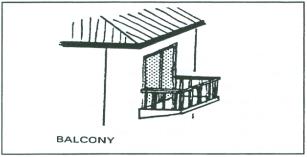
“Bar” means premises used primarily for the dispensing of alcoholic beverages by the drink for on-site consumption. Food may be served for consumption primarily on the premises as accessory to the principal use.
“Basement” means a space having one-half or more of its floor-to-ceiling height above the average level of the adjoining ground and with a floor-to-ceiling height of not less than six and one-half feet.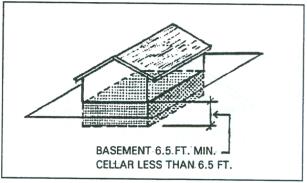
“Bedroom” means a private room planned and intended for sleeping, separated from other rooms, and accessible to a bathroom without crossing another bedroom.
“Berm” means a mound of earth or the act of pushing earth into a mound.
Boarding, Animal. “Animal boarding” means a property, or part thereof, on which animals not belonging to the property owner or property resident, are kept and cared for.
“Boarding house” means a residence other than hotel or single-family housekeeping unit, wherein three or more rooms are rented under three or more separate written or oral rental agreements, leases or subleases or combination thereof, whether or not the owner, agent or rental manager resides within the residence. Meals and lodging may be provided as part of the compensation paid by the tenants, as well as personal and financial services.
“Buildable area” means the area of a lot remaining after the minimum yard and open space requirements of the zoning ordinance have been met.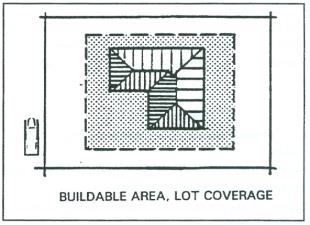
“Building” means any structure having a roof supported by columns or walls and intended for the shelter, housing, or enclosure of any individual, animal, process, equipment, goods, or materials of any kind.
“Building frontage” means the lineal measurement of a building facade which fronts on a street, public street, or access way and used to calculate permissible signage.
“Building height” means the vertical distance from finished grade to the highest point of the structure.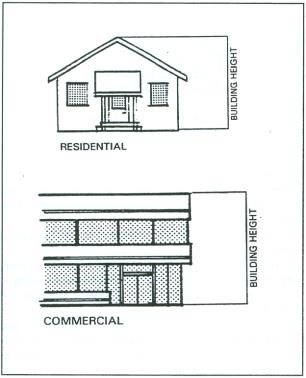
“Building permit” means written permission issued by the city for the construction, repair, alteration, or addition to a structure or building.
“Bus stop shelter” means a small, roofed structure, usually having three walls, located near a street and designed primarily for the protection and convenience of bus passengers. (Ord. 2018-3 § 4 (part); Ord. 2016-6 § 3 (part); Ord. 98-8 § 2 (part): prior code § 9-02.020)
9-04.030 “C” definitions.
“Candlepower” means luminous intensity expressed in footcandles.
“Canopy” means a fixed roofed structure of any material projecting from and connected to a building, column, or post or supported by a frame extending from a building and/or posts.
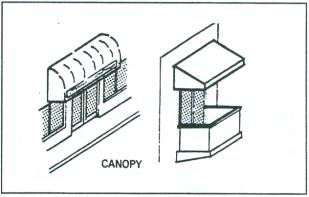
“Capital improvement,” when pertaining to government, means the acquisition of real property, major construction projects, or acquisition of expensive equipment expected to last a long time.
“Capital improvements program” means a timetable or schedule for all future capital improvements to be carried out during a specific period and listed in order of priority, together with cost estimates and the anticipated means and sources of financing each project.
“Caretaker’s quarters” means a dwelling unit intended for use by a person or family whose primary function is to safeguard the property.
“Car pool,” “car pooling” means two or more people commuting on a regular basis to and from work by means of a privately owned vehicle.
“Carport” means a roofed structure providing space for the parking of motor vehicles and enclosed on not more than three sides.
“Car wash” means any commercial building or premises or portions used for the washing of motor vehicles.
Car Wash, Automatic. “Automatic car wash” means a structure containing facilities for washing vehicles and automatic or semiautomatic application of cleaner, brushes, rinse water, and heat for drying.
Car Wash, Self Service. “Self service car wash” means a commercial facility containing coin operated machinery for vacuuming, washing, rinsing and drying of vehicles.
“Cellar” means a space with less than one-half of its floor-to-ceiling height above the average finished grade of the adjoining ground or with a floor-to-ceiling height of less than six and one-half feet.
“Cemetery,” “mausoleum,” “crematory” means property used for the preparation and interring of the dead.
“Certificate of compliance” means a document issued by the proper authority affirming that the plans for a proposed use meet all applicable codes and regulations.
“Certificate of use and occupancy” means a document issued by a governmental authority allowing the occupancy or use of a building and certifying that the structure or use has been constructed and will be used in compliance with all the applicable municipal codes and ordinances.
“Change of use” means a conversion of use that substantially differs from the previous use of a portion of building or land.
“Child-care center” means an establishment providing for the care, supervision, and protection of children.
“Church/temple” means a building or structure, or groups of buildings or structures, that by design and construction are primarily intended for conducting organized religious services and associated accessory uses. “Church” includes mosque, temple, synagogue, cathedral or similar religious institutions.
“Circulation” means systems, structures, and physical improvements for the movement of people, goods, water, air, sewage, or power by such means as streets, highways, railways, waterways, towers, airways, pipes, and conduits.
“Club” means a group of people organized for a common purpose to pursue common goals, interests, or activities and usually characterized by certain membership qualifications, payment of fees and dues, regular meetings, and a constitution and bylaws.
“Cocktail lounge” means premises used to sell liquor, or alcoholic beverages by the drink, and in which live entertainment and food may be offered as accessory to the principal use.
“College” means an educational institution authorized by the state awarding associate or higher degrees.
“Commercial use” means activity involving the sale of goods or services carried out for profit.
“Commercial recreation” means any use or development, either public or private, providing amusement, pleasure or sport, diversion, exercise or other resource affording relaxation and enjoyment which is operated primarily for financial gain. Typical uses may include, but are not limited to: batting cages, skating rinks, and miniature golf courses.
“Communication facility” means the antenna, antenna support structures, and buildings used for purposes of transmitting or receiving telecommunication signals.
“Community association” means a homeowners association organized to own, maintain, and operate common facilities and to enhance and protect their common interests.
“Community care facility” means any state licensed facility, place or building that is maintained and operated to provide nonmedical residential care, day treatment, adult day care, or foster family agency services for children and/or adults including but not limited to the physically handicapped, mentally impaired, incompetent persons, and abused or neglected children. A community care facility may also include family day care homes and day care centers. Chapter 9-64 contains a list of such facilities.
“Community center” means:
1. A building used for recreational, social, educational, and cultural activities, open to the public or a designated part of the public, usually owned and operated by a public or nonprofit group or agency.
2. A building or structure owned and operated by a governmental agency to provide a governmental service to the public.
“Community character” means the image of a community or area as defined by such factors as its built environment, natural features and open space elements, type of housing, architectural style, infrastructure, and the type and quality of public facilities and services.
“Community shelters” means a residence providing food, shelter, medical care, legal assistance, personal guidance, and other services to persons who require shelter and assistance in order to protect their physical or psychological welfare.
“Complete application” means an application form completed as specified by ordinance and the rules and regulations of the governmental agency and all accompanying documents required by ordinance for approval of the application.
“Concept plan” means informal plan for development that carries no vesting rights or obligations.
“Condemnation” means:
1. The exercise by a governmental agency of the right of eminent domain;
2. The declaration by a public official/agency that buildings in a serious state of deterioration/dilapidation must be vacated and destroyed to maintain public health and safety.
“Conditional use” means a use permitted in a particular zoning district upon showing that such use in a specified location will comply with all the conditions and standards for the location or operation of the use as specified in the zoning ordinance and authorized by the approving agency.
“Conditional use permit” means a permit issued by the approving agency stating that a use as conditioned, not allowed as a right of zone, may be operated subject to specific limitations.
“Condominium” means a building, or group of buildings, in which dwelling units, offices, or floor area are owned individually, and the structure, common areas, and facilities are owned by all the owners on a proportional, undivided basis.
“Conference/convention facility” means a facility used for convention conferences and seminars, which may contain accommodations for sleeping, food preparation and eating, recreation, entertainment, resource facilities, and meeting rooms; including buildings or groups of buildings designed to house large assemblies of people and/or serve as a location in which large scale exhibits of merchandise may be held.
“Congregate living health facility” means a residential home with a capacity of no more than six beds, that provides inpatient care, and as further defined by Health and Safety Code Section 1250(i).
“Construction office” means a temporary structure or a portion of an existing structure used as the primary management location for buildings or uses under construction.
“Convalescent facility” means a facility licensed by the State Department of Public Health, the State Department of Social Welfare, or the county, which provides bed and ambulatory care for patients for post operative convalescent, chronic illness or dietary problems, and persons unable to care for themselves. Such facilities do not include alcoholics, drug addicts, or persons with mental or contagious diseases or afflictions.
“Convenience store” means any small retail establishment offering for sale prepackaged food products, beverages, household items, newspapers, magazines, sandwiches and/or other freshly prepared foods, such as salads, for off-site consumption.
“Covenant agreement” means a recorded legal instrument, whether separate or included within a deed, establishing limitations or restrictions upon property usage or development of the legally described property.
“Critical area” means an area with one or more of the following environmental characteristics:
1. Steep slopes;
2. Flood plain;
3. Soils classified as having high water tables;
4. Soils classified as highly erodible, subject to erosion, or highly acidic;
5. Land incapable of meeting percolation requirements;
6. Land formerly used for landfill operations or hazardous industrial use;
7. Fault areas;
8. Stream corridors;
9. Estuaries;
10. Mature stands of native vegetation;
11. Aquifer recharge and discharge areas;
12. Wetlands and wetland transition areas; and
13. Habitats of endangered species.
“Cul-de-sac” means the turnaround at the end of a dead-end street.
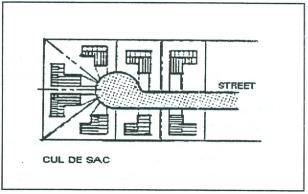
“Cultural facilities” means establishments that document the social and religious structures and intellectual and artistic manifestations that characterize a society and include museums, art galleries, and botanical and zoological gardens of a natural, historic, educational, or cultural interest. (Ord. 2016-6 § 3 (part); Ord. 98-8 § 2 (part): prior code § 9-02.030)
9-04.040 “D” definitions.
“Day care center” means any child day care facility other than a family day care home, including infant centers, preschools, and extended day care facilities.
Day Care Home, Family. “Family day care home” means any child day care facility that regularly provides care, protection, and supervision for fourteen (14) or fewer children, in the provider’s own home, for periods of less than twenty-four (24) hours per day, while the parents or guardians are away.
“Deck” means a platform, either free-standing or attached to a building, but without a roof, that is supported by pillars, posts, or walls.
“Dedication” means the transfer of property by the owner to a public agency or utility for specific purposes such as streets and roads, or utility or park usage.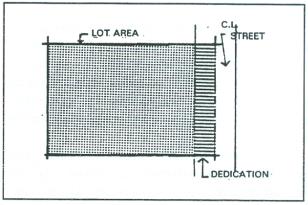
“Density” means the number of families, individuals, dwelling units, households, or housing structures per unit of land.
“Density bonus” means a process by which a city can increase the density within a development project by a percentage established by law or through which the city offers incentives supporting economic viability of the project provided the developer provides guarantees with respect to the preservation of the rights of use or sale for affordable housing purposes.
“Density transfer” means the transfer of all or part of the permitted density on a parcel to another parcel.
“Department store” means a large retail store arranged into departments for the sale of a variety of consumer goods.
“Dependent and neglected children homes (foster homes)” means community care facilities providing care and protection for dependent and neglected children.
“Design standards” means a set of guidelines defining parameters to be followed in site and/or building design and development or landscape design.
“Developer” means the legal or beneficial owner or owners of a lot or of any land included in a proposed development, including the holder of an option or contract to purchase or other persons having enforceable proprietary interests in such land.
“Development” means the construction, reconstruction, conversion, structural alteration, relocation, or enlargement of any structure; any mining, excavation, landfill, or land disturbance; and any use or extension of the use of land.
“Development agreement” means a contract between the city and a developer through which the developer receives vested rights to construct a project subject to specific requirements benefiting the community.
“District” means a part, zone, or geographic area within the municipality within which certain zoning or development regulations apply.
“Drainage” means:
1. Surface water runoff;
2. The removal of surface water or groundwater from land by drains, grading, or other means, which include runoff controls to minimize erosion and sedimentation during and after construction or development.
“Drainage area” means a geographical area, formed by topography, which collects and changes surface runoff from precipitation to natural or man made channels.
“Drainage district” means a district established by a governmental unit to build and operate facilities for drainage.
“Drainage system” means pipes, swales, natural features, and man-made improvements designed to carry drainage.
“Drive-thru” means any portion of a building or development intended to allow service direct from the building through a window, kiosk, or automated delivery system to vehicle occupants. Such facilities include but are not limited to food service windows, ready tellers, or similar service systems.
“Driveway” means a private roadway providing property access to a street or highway.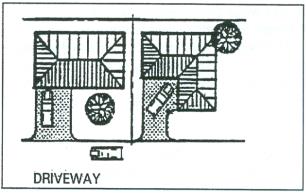
“Drug abuse/alcohol recovery facility” means a community care facility, premises, place or building that provides twenty-four (24) hour residential nonmedical services to adults who are recovering from problems related to alcohol, drug or alcohol and drug misuse or abuse, and who need alcohol, drug, or alcohol and drug recovery treatment or detoxification services.
Dwelling, Attached. “Attached dwelling” means a dwelling joined to one or more other dwellings by common vertical walls.
Dwelling, Detached. “Detached dwelling” means a dwelling that is not attached to any other dwelling by any physical means.
Dwelling, Duplex. “Duplex dwelling” means a building containing two single-family dwelling units totally separated from each other by a common wall (the wall may only go to the ceiling).
Dwelling, Multiple-Family. “Multiple-family dwelling” means a building on a single lot containing two or more dwelling units, each of which is totally separated from the other by an unpierced wall extending from ground to roof or an unpierced ceiling and floor extending from exterior wall to exterior wall, except for a common stairwell exterior to both dwelling units.
Dwelling, Single-Family Attached. “Single-family attached dwelling” means residential housing units where independent units are created but are attached by common walls such that not more than three units are so joined.
Dwelling, Single-Family Detached. “Single-family detached dwelling” means a building containing one dwelling unit and that is not attached to any other dwelling by any means and is surrounded by open space and yards.
Dwelling, Single-Room Occupancy. “Single-room occupancy dwelling” means a housing type consisting of one room, often with cooking facilities and with private or shared bathroom facilities.
“Dwelling unit” means one or more rooms, designed, occupied, or intended for occupancy as a separate living quarter with cooking, sleeping, and sanitary facilities provided within the dwelling unit for the exclusive use of a single-family housekeeping unit.
Dwelling Unit, Efficiency. “Efficiency dwelling unit” means a dwelling unit consisting of not more than one habitable room together with kitchen or kitchenette and sanitary facilities. (Ord. 2016-6 § 3 (part); Ord. 98-8 § 2 (part): prior code § 9-02.040)
9-04.050 “E” definitions.
“Easement” means a grant of one or more of the property rights by the property owners to and/or for use by the public, a corporation, or another person or entity.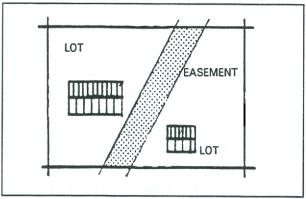
“Eating and drinking places” means retail establishments selling food and alcoholic beverages for consumption on the premises, including lunch counters and refreshment stands selling prepared foods and drinks for immediate consumption.
“Eave” means the projecting lower edges of a roof overhanging the wall of a building.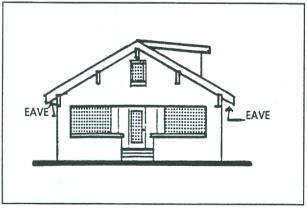
“Elevation” means:
1. A vertical distance above or below a fixed reference level;
2. A dimensioned drawing of the front, rear, or side of a building showing features such as windows, doors, and relationship of grade to floor level.
“Emergency shelter” means housing with minimal supportive services for homeless persons that is limited to occupancy of six months or less by a homeless person, or as may be amended by Health and Safety Code Section 50801(e). No individual or household may be denied emergency shelter because of an inability to pay.
“Emission” means a discharge of pollutants into the air or water.
“Encroachment” means any obstruction or intrusion in a delineated floodway, right-of-way, or on adjacent land.
“Endangered species” means wildlife species whose prospects for survival are in immediate danger because of a loss or change in habitat, overexploitation, predation, competition, disease, disturbance, or contamination and designated as such by a governmental agency.
“Enlargement” means an increase in the size of an existing structure or use, including physical size of the property, building, parking, and other improvements.
“Equipment rental” means the use of a building or land for the purpose of providing tools, implements, or other articles to individuals or businesses on a temporary basis for a specified fee.
“Equitation facilities” means facilities providing support to horses or the raising and use of horses for sport or pleasure. Such facilities may include riding clubs, corrals, stables, training arenas, trails and equipment storage.
“Escort/dating service” means a person or business entity which, for any form of consideration, furnishes, offers to furnish, or advertises to furnish an escort or escorts as one of its primary business purposes.
“Establishment of an adult entertainment business” means and includes any of the following:
1. The opening or commencement of any such business as a new business;
2. The conversion of an existing business, whether or not an adult entertainment business, to any of the adult entertainment business defined herein;
3. The addition of any of the adult entertainment businesses defined herein to any other existing adult entertainment business; or
4. The relocation of any such business.
“Excavation” means removal or recovery by any means whatsoever of soil, rock, minerals, mineral substances, or organic substances, other than vegetation, from water or land, on or beneath the surface thereof, or beneath the land surface, whether exposed or submerged.
“Extension” means:
1. An increase in the amount of existing floor area beyond the existing exterior wall; or
2. An increase in the amount of time that a permit or approval may be valid. (Ord. 2012-5 § 1; Ord. 98-8 § 2 (part): prior code § 9-02.050)
9-04.060 “F” definitions.
“Facade” means the exterior walls of a building exposed to public view.
“Facility for handicapped persons” means community care facilities providing for the care and services to physically impaired or disabled persons.
“Facility for mentally disordered persons” means community care facilities within a residential setting providing for the care and protection of persons having diminished mental capacity.
“Fair market value” means the price of a building or land that would be agreed upon voluntarily in fair negotiations between a knowledgeable owner willing, but not forced, to sell and a knowledgeable buyer willing, but not forced, to buy.
“Family” means a group of individuals not necessarily related by blood, marriage, adoption, or guardianship living together in a dwelling unit as a single housekeeping unit under a common housekeeping management plan based on an intentionally structured relationship providing organization and stability.
Family Day Care Home, Large. “Large family day care home” means a home that provides family day care for seven to fourteen (14) children, including children under the age of ten years who reside at the home.
Family Day Care Home, Small. “Small family day care home” means a home that provides family day care for eight or fewer children, including children under the age of ten years who reside at the home.
“Fence” means an artificially constructed barrier erected to enclose, screen, or separate areas.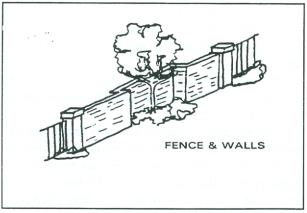
“Financial institution” means a business or institution engaged in monetary transactions such as banks, and savings and loan institutions.
“Finished elevation” means:
1. The elevation of the land surface of a site after completion of all site preparation work; and/or
2. The completed architectural surfaces of a building.
“Fiscal impact analysis” means an analysis of the costs and revenues associated with impacts to a public agency of a specific development proposal(s).
“Flag” means the symbol, insignia, or display of a governmental or nonprofit organization when not displayed in connection with a commercial promotion or used as an advertising mechanism.
“Flood hazard area” means the flood plain consisting of the floodway and the flood fringe area.
“Flood Insurance Rate Map” means the official map on which the Federal Insurance Administration has delineated both the areas of special flood hazards and the risk premium zones applicable to the community.
Floor Area, Gross. “Gross floor area” means the sum of all areas of the floors of a building or structure from the exterior face of exterior walls, or from the centerline of a wall separating two buildings, but excluding any space where the floor-to-ceiling height is less than six feet.
Floor Area, Net. “Net floor area” means the total of all floor areas of a building, excluding stairwells and elevator shafts, equipment rooms, interior vehicular parking or loading, and all floors below the first or ground floor, except when used or intended to be used for human habitation or to provide service to the public.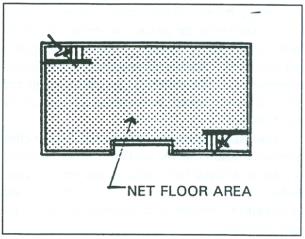
“Floor Area Ratio” means the gross floor area of all buildings or structures on a lot divided by the total lot area.
“Fortune telling” means the telling of fortunes, forecasting of futures, or furnishing any information not otherwise obtainable by the ordinary process of knowledge, by means of any occult or psychic power or faculty or force, clairvoyance, cartomancy, phrenology, spirits, mediumship, seership, prophecy, augury, astrology, palmistry, necromancy, mindreading, telepathy, or other craft, science, cards, talisman, charms, potions, magnetism, magnetized articles, or substances, mysteries or magic of any kind or nature, or numerology, or the carrying on of any art, profession, or business, the advertisement and practice of which is regulated by this code.
“Foster home” means a community care facility consisting of a residential structure/unit providing care and lodging to children in a family environment.
“Fraternal organization” means a group of people formally organized for a common interest, usually cultural, religious, or entertainment, with regular meetings, rituals, and formal written membership requirements.
“Fraternity/sorority house” means a building containing sleeping rooms, bathrooms, common rooms, central kitchen and dining room and maintained exclusively for members and their guests or visitors and affiliated with an institution of higher learning.
“Funeral home,” “mortuary” means a building used for the preparation of the deceased for burial or cremation and the display of the deceased and rituals connected therewith before burial or cremation. (Ord. 98-8 § 2 (part): prior code § 9-02.060)
9-04.070 “G” definitions.
“Garage” means a building, or parking structure, or part thereof, used or intended to be used for the parking and storage of vehicles.
Garage, Private. “Private garage” means a garage used exclusively for the parking and storage of vehicles owned or operated by residents of nearby dwelling units and their guests, which is not operated as a commercial enterprise and is not available to the general public and which is owned, leased, or cooperatively operated by such residents.
“Gas station” means any building, land area, or other premises, or portion thereof, used for the retail dispensing or sales of vehicular fuels, servicing and repair of automobiles, to include as an accessory use the sale and installation of lubricants, tires, batteries, and similar vehicle accessories.
“Gentlemen’s club” means a business which is conducted exclusively for the patronage of adults and as to which minors are specifically excluded from patronage, either by law and/or by the operators of such businesses, and features adult entertainment or which is characterized by an emphasis upon “specified sexual activities” and/or “specified anatomical areas.”
“Glare” means the effect produced by brightness sufficient to cause annoyance, discomfort, or loss in visual performance and visibility.
“Golf driving range” means a commercial recreational use, or accessory use to a golf course, where persons may practice long distance shots. Such facilities are generally outdoor uses.
“Government agency” means any department, commission, independent agency, or instrumentality of the United States, of a state, county, incorporated or unincorporated municipality, authority, district, or other government unit.
“Government facility” means a building or area housing offices, and/or support facilities for any seat of any federal, state, county, city, or district agency providing services to the general population.
“Grade” means:
1. The average elevation of the land around a building;
2. The percent of rise or descent of a sloping surface.
Grade, Finished. “Finished grade” means the final elevation of the ground level after development.
Grade, Natural. “Natural grade” means the elevation of the ground level in its natural state, before construction.
“Grading” means any stripping, cutting, filling, or stockpiling of earth or land, including the land in its cut or filled condition, to create new grades.
“Green house” means a building whose roof and sides are made largely of glass or other transparent or translucent material and in which the temperature and humidity can be regulated for the cultivation of plants.
“Ground floor” means the first floor of a building other than a cellar or basement.
“Group home” means a residential facility which provides licensed, twenty-four (24) hour nonmedical care and supervision to occupants, provides service specified in state regulations, and maintains a structured environment with such services provided at least in part by paid staff.
“Growth management” means techniques used by the government to control the rate, amount, location, timing, and type of development.
“Guest quarters” means an accessory structure of four hundred (400) square feet or less intended to house the guests of the owner/occupant of a primary dwelling unit. Guest quarters shall not include a kitchen or related facilities and shall consist of not more than a bedroom, bath and sitting room.
“Gymnasium” means a recreational facility meant to provide locations for a variety of indoor oriented participatory athletic events. (Ord. 98-8 § 2 (part): prior code § 9-02.070)
9-04.080 “H” definitions.
“Habitat” means the sum total of all the environmental factors of a specific place that is occupied by an organism, population, or a community.
“Handicapped person” means a person or persons who may be classified as having a physical impairment that manifests itself in one or more of the following ways: nonambulatory; semiambulatory; visually impaired, deaf or hard of hearing; having faulty coordination; and having reduced mobility, flexibility, coordination, or perceptiveness due to age or physical or mental conditions.
“Health care facility” means a facility or institution, whether public or private, principally engaged in providing services for health maintenance and the treatment of mental or physical conditions. Health care facilities as well as establishments providing support to the medical profession and patients, such as medical and dental laboratories, blood banks, or oxygen, and miscellaneous types of medical supplies and services.
“Health club” means an establishment that provides facilities for aerobic exercises, running and jogging, exercise equipment, game courts, swimming facilities, and saunas, showers, massage rooms, and lockers.
“Heliport” means an area, either at ground level or elevated on a structure, permitted by the federal government or an appropriate state agency and approved for the loading, landing, and takeoff of helicopters and including auxiliary facilities, such as parking, waiting room, fueling, and maintenance equipment.
“Historic building” means any building or structure that is historically or architecturally significant.
“Historic preservation” means the protection, rehabilitation, and restoration of districts, sites, buildings, structures, and artifacts significant in history, architecture, archaeology, or culture.
“Home occupation” means any activity carried out for gain by a resident and conducted as a customary, incidental, and accessory use in the resident’s dwelling unit.
“Homeowners association” means a community association, that is organized in a development, in which individual owners share common interests and responsibilities for costs and upkeep of common open space or facilities.
“Hospital” means a building providing primary health services and medical or surgical care to persons, primarily inpatients, suffering from illness, disease, injury, deformity, and other abnormal physical or mental conditions, and including, as an integral part of the institution, related facilities, medical offices, and staff residences.
“Hotel” means a facility offering transient lodging accommodations to the general public and providing additional services, such as restaurants, meeting rooms, entertainment, and recreational facilities.
“Housing unit” means a room or group of rooms used by one or more individuals living separately from others in the structure, with direct access to the outside or to a public hall and containing separate bathroom and kitchen facilities. (Ord. 2016-6 § 5; Ord. 98-8 § 2 (part): prior code § 9-02.080)
9-04.090 “I” definitions.
“Inclusionary housing program” means a housing strategy aimed at insuring each development project incorporates directly within the project or supports availability of housing for very low, low, and moderate income housing units at a predetermined ratio.
Industry, Service. “Service industry” means a business whose primary purpose is to provide a service, as opposed to a product to consumers. Examples include tooling, machining, printing, testing and repairing of equipment. Service industries do not include retail and service businesses.
“Infrastructure” means facilities and services needed to sustain industry, residential, commercial, and all other land use activities, such as water or sewer systems.
“Information center” means a building or portion thereof used to provide information about events, public transit, or tourist attractions to the general public.
“Ingress” means access or entry.
“Institutional use” means a nonprofit, religious, or public use, such as a church, library, public or private school, hospital, or government owned or operated building, structure, or land used for public purpose.
“Intensity of use” means the number of dwelling units per acre for residential development and floor area ratio (FAR) for nonresidential development, such as commercial, office, and industrial.
“Intermediate care facility” means a facility with a capacity of four to fifteen (15) beds and is either an intermediate care facility, a developmentally disabled care facility or a nursing facility as defined by Health and Safety Code Sections 1250(e) and (h) respectively.
“Intersection” means the location where two or more roadways cross at the same grade.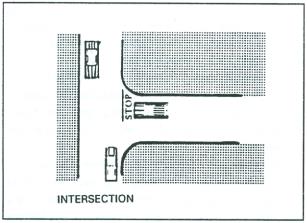
“Intersection and link analysis” with regard to traffic study and analysis, means that portion of traffic studies intended to define conditions and impacts at intersections and along segments of the streets to determine the level of service and capacity of the street system. (Ord. 98-8 § 2 (part): prior code § 9-02.090)
9-04.100 “J” definitions.
“Junk” means any scrap, waste, reclaimable material, or debris, whether or not stored, for sale or in the process of being dismantled, destroyed, processed, salvaged, stored, baled, or disposed of. (Ord. 98-8 § 2 (part): prior code § 9-02.100)
9-04.110 “K” definitions.
“Kennel” means a commercial establishment in which dogs and/or domesticated animals are housed, groomed, bred, boarded, trained, or sold, for a fee.
“Kiosk” means:
1. A freestanding structure upon which temporary information and/or posters, notices, and announcements are posted;
2. A small freestanding structure used to house quick sales and service to walk-up or drive-up customers (e.g., photomats, key suppliers). (Ord. 98-8 § 2 (part): prior code § 9-02.110)
9-04.120 “L” definitions.
“Land use” means a description of how land is occupied or utilized.
“Landscape” means:
1. An expanse of natural scenery;
2. Lawns, trees, plants, and other natural materials, such as rock and wood chips, and decorative features, including sculpture, patterned walks, fountains, and pools.
“Landscape plan” means a component of a development plan on which is shown: proposed landscape species (such as number, spacing, size at time of planting, and planting details); proposals for protection of existing vegetation during and after construction; proposed treatment of hard and soft surfaces; proposed decorative features; grade changes; buffers and screening devices; and any other information that can reasonably be required in order that an informed decision can be made by the approving authority.
Landscape Plan, Conceptual. “Conceptual landscape plan” means a plan which shows the general mix and placement of vegetation and other materials to be used in a development or project.
Landscape Plan, Final. “Final landscape plan” means a plan drawn to scale which depicts the actual location, type, size, names, colors and provision of plants, hardscape materials, planters and all areas intended to be landscaped. Plans typically include plan views, architectural elevations, detail sheets, irrigation system design, placement and general notes related to the construction, inspection and long term maintenance of landscaped areas.
“Legal nonconforming” means any structure, use, property or sign which was legally established and maintained in conformance with the development code in effect at the time of original installation, construction, or implementation that because of size, height, location, design, construction, modification to the development code, or other circumstance is not in conformance with the requirements of the current development code.
“Legislative act” is the means by which the legislative arm of government renders decisions, such as minute actions, resolutions and ordinances.
“Level of service (LOS)” means a technical term describing traffic congestion conditions along a given roadway or at a particular intersection.
Library, Public and Private. “Public and private library” means a building generally operated by a governmental, institutional or special district in which collections of books and various reference materials, printed or electronic media are housed for public use. Private libraries are similar facilities to public libraries but access and use is restricted to specific users and precludes general public access.
“Liquor store” means a retail or wholesale establishment where packaged alcoholic and nonalcoholic beverages are dispensed in bulk containers, rather than by the drink.
“Loading space” means an off-street space or berth used for the loading or unloading of cargo, products, or materials from vehicles.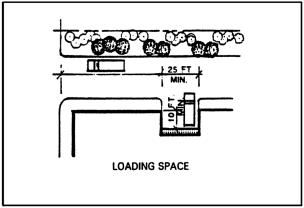
“Lodge” means:
1. The place where members of a local chapter of an association or fraternal, cultural, or religious organization hold their meetings;
2. The local chapter itself.
Lot, Corner. “Corner lot” means a lot or parcel of land abutting upon two or more streets at their intersection or upon two parts of the same street forming an interior angle of less than one hundred thirty-five (135) degrees.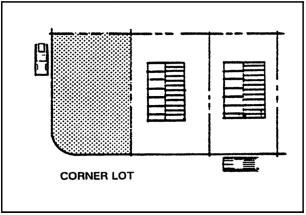
Lot, Cul-de-sac. “Cul-de-sac lot” means a lot on which the curve of a cul-de-sac represents fifty (50) percent or more of the property frontage.
Lot, Flag. “Flag lot” means a lot not meeting minimum frontage requirements but meeting all building and lot area requirements of the zone where access to a public road is by a narrow, private right-of-way or driveway.
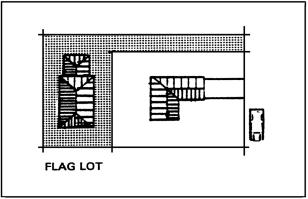
Lot, Gore-shaped. “Gore-shaped lot” means a triangular or tapered shaped lot.
Lot, Improved. “Improved lot” means:
1. A lot upon which a building can be constructed and occupied;
2. A lot with buildings or structures.
Lot, Interior. “Interior lot” means a lot other than a corner lot.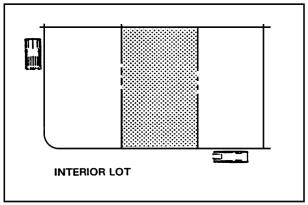
Lot, Minimum Area of. “Minimum area of lot” means the smallest lot area established by the zoning ordinance on which a use or structure may be located in a particular district.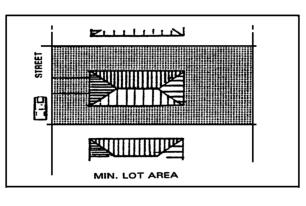
Lot, Reverse Frontage. “Reverse frontage lot” means a through lot that is not accessible from one of the parallel or nonintersecting streets upon which it fronts.
Lot, Substandard. “Substandard lot” means a parcel of land that has less than the minimum area or minimum dimensions required by the zone in which the lot is located.
Lot, Through. “Through lot” means a lot that fronts upon two parallel streets or that fronts upon two streets that do not intersect at the boundaries of the lot.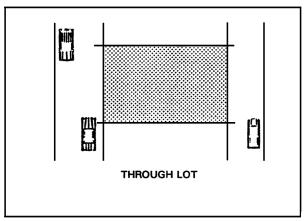
“Lot area” means the total area within the lot lines of a lot, excluding any street rights-of-way.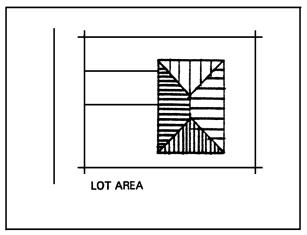
“Lot coverage” means that portion of the lot that is covered by buildings.
“Lot depth” means the average distance measured from the front lot line to the rear lot line.
“Lot frontage” means the length of the front lot line measured at the street right-of-way line. For flag lots, that portion of a lot, not including the pole portion, that is generally parallel to the access street.
“Lot line” means a line of record bounding a lot that divides one lot from another lot or from a public or private street or any other public space.
Lot Line, Front. “Front lot line” means the lot line separating a lot from a street right-of-way.
Lot Line, Rear. “Rear lot line” means the lot line opposite and most distant from the front lot line. In the case of triangular or otherwise irregularly shaped lots, a line ten feet in length entirely within the lot, parallel to and at a maximum distance from the front lot line.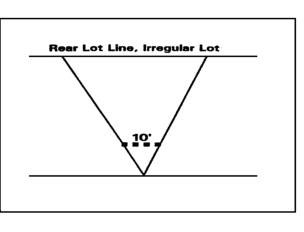
Lot Line, Side. “Side lot line” means any lot line other than a front or rear lot line.
“Lot of record” means a lot that exists as shown or described on a plat or deed in the records of the County Recorder.
“Lot width” means the horizontal distance between the side lines of a lot measured at right angles to its depth along a straight line parallel to the front lot line at the minimum required building setback line. (Ord. 98-8 § 2 (part): prior code § 9-02.120)
9-04.130 “M” definitions.
“Manufactured housing” means factory built, single-family structures that meet the National Manufactured Home Construction and Safety Standards Act (42 U.S.C. Sec. 54010), commonly known as HUD (U.S. Department of Housing and Urban Development) code.
“Manufacturing” means the mechanical or chemical transformation of materials or substances into new products, including the assembling of component parts, the creation of products, and the blending of materials, such as lubricating oils, plastics, resins, or liquors.
“Marijuana business” means any activity, whether or not carried out for commercial gain, which involves cultivation, possession, manufacture, processing, storage, laboratory testing, labeling, transportation, distribution, or sale of marijuana or any marijuana-infused products. This definition shall include any of the foregoing activities conducted by or on behalf of a qualified patient or the primary caregiver of a qualified patient. All references in this section to “marijuana business” shall be synonymous with “marijuana dispensary,” “mobile marijuana dispensary,” and “marijuana cultivation site,” which are defined in Chapter 9-103. The term “marijuana business” shall not include “personal cultivation of marijuana,” as defined in Chapter 9-103.
“Marquee” means any hood, canopy, awning, or permanent construction that projects from a wall of a building, usually above an entrance.
“Mass transit” means a public common carrier transportation system for people having established routes and fixed schedules.
“Massage” or “massage services” means any method of applying pressure on, causing friction against, stroking, kneading, rubbing, tapping, pounding, vibrating, acupressure, or bodywork, stimulating, compression on or movement of the external parts of the human body of another, either directly with the hands or some other body part, with or without the aid of or by means of any mechanical or electrical apparatus, hot stones, or other appliance or device, for money or any form of consideration. Massage may incorporate supplementary aids such as rubbing alcohol, liniment, antiseptic, oil, powder, cream, lotion, ointment or other similar preparations commonly used in this practice.
“Massage establishment” means any business or establishment with a fixed location within the city of Laguna Hills where any individual, firm, association, partnership, limited liability company, corporation, or combination of individuals offers, engages in, conducts, carries on or permits to be engaged in, conducted or carried on massage services within the city, including the business office of a sole provider who provides massage services at such business office. Any type of business or establishment at which massage services are provided shall be considered a massage establishment for purposes of this title, regardless if the business holds itself out as something other than a massage establishment and/or also offers or provides other types of products or services. Any business or establishment that offers any combination of massage services and sauna facilities, including, but not limited to, showers, baths, wet and dry heat rooms, pools and hot tubs, shall be deemed a massage establishment under this title.
“Master plan” means a comprehensive, long-range plan intended to guide the growth and development of a community or region that typically includes inventory and analytic sections leading to recommendations for the community’s future economic development, housing, recreation and open space, transportation, community facilities, and land use, all related to the community’s goals and objectives for these elements.
“Master sign program” means a program to provide incentive, latitude, and variety in order to achieve aesthetically appealing and compatible signage for shopping and professional office centers, industrial parks and other commercial sites.
“Median” means:
1. The middle number in a series of items in which fifty (50) percent of all figures are above the median and fifty (50) percent are below;
2. An island in the center of a street, highway, or other surface intended for vehicle circulation that separates opposing traffic flows.
“Medical clinic/office” means an establishment where patients are admitted for examination and treatment on an outpatient basis by one or more physicians, dentists, other medical personnel, psychologists, or social workers (excluding veterinarians) and where patients are not housed overnight.
“Mini-warehouse” means a complex or structure containing leased or rented separate, private storage spaces of varying sizes.
“Mitigation” means methods used to alleviate or lessen the impact of development.
“Mixed-use development” means the development of a tract of land, building, or structure with a variety of complementary and integrated uses, such as, but not limited to, residential, office, manufacturing, retail, public, or entertainment, in a compact urban form.
“Mixed-use zoning” means regulations that permit a combination of different uses within a single development area.
Mobile Home. See “manufactured housing.”
“Mobile home park” means a site containing spaces with required improvements and utilities that are leased for the long-term placement of manufactured houses and that may include services and facilities for the residents.
“Model home complex” means residential units and a temporary sales office in a development used to illustrate the design of the units to potential home-buyers during market and sale of units.
“Motel” means an establishment providing transient sleeping accommodations with a majority of all rooms having direct access to the outside without the necessity of passing through the main lobby of the building.
“Motion picture theater” means a commercial recreation facility where motion pictures or other visual media are shown to the public for a fee.
“Museum” means a building or room, or any grouping thereof, used to exhibit works of art, displays of historic objects, displays of scientific objects, or displays of memorabilia open to the public. (Ord. 2017-5 §§ 3, 4; Ord. 2017-3 § 5; Ord. 2016-4 §§ 6, 7; Ord. 2013-2 § 3; Ord. 2011-2 § 1 (Exh. A (part)); Ord. 2003-6 § 2: Ord. 98-8 § 2 (part): prior code § 9-02.130)
9-04.140 “N” definitions.
“Neighborhood” means an area of a community with characteristics that distinguish it from other areas and that may include distinct ethnic or economic characteristics, housing types, schools, or boundaries defined by physical barriers, such as major highways and railroads or natural features, such as rivers.
“Neighborhood park” means an open area of two to five acres in size and including lawn area, trees, shrubbery, walks, benches, a focal point such as a fountain or statue, sandbox, play apparatus, and table game area.
“Nightclub” means an establishment dispensing liquor with or without meals and in which music, dancing, or entertainment is featured.
“Noise” means an undesired audible sound.
“Nonconforming lot” means a lot, the area, dimensions, or location of which was lawful prior to the adoption, revision or amendment of the zoning ordinance but that fails by reason of such adoption, revision, or amendment to conform to the present requirements of the zoning district.
“Nonconforming sign” means a sign lawfully existing on the effective date of an ordinance, or amendment thereto, that renders such sign nonconforming because it does not conform to all the standards and regulations of the ordinance.
“Nonconforming structure or building” means a structure or building, the size, dimensions, or locations of which was lawful prior to the adoption, revision, or amendment to the zoning ordinance but that fails by reason of such adoption, revision, or amendment to conform to the present requirements of the zoning district.
“Nonconforming use” means a use or activity that was lawful prior to the adoption, revision, or amendment of the zoning ordinance but that fails by reason of such adoption, revision, or amendment to conform to the present requirements of the zoning district.
“Nuisance” means an interference with the enjoyment and use of property.
“Nursing and intermediate care facility” means community care facilities providing health services to confined patients in congregate care settings. (Ord. 98-8 § 2 (part): prior code § 9-02.140)
9-04.150 “O” definitions.
“Occupancy” or “occupied” means the residing of an individual or individuals overnight in a dwelling unit or the storage or use of equipment, merchandise, or machinery in any public, commercial, or industrial building.
“Occupancy permit” means a permit allowing the use of a building or structure after it has been determined that all the requirements of applicable ordinances have been met.
“Office” means a room or group of rooms used for conducting the affairs of a business, profession, service, industry, or government and generally furnished with desks, tables, files, and communication equipment.
“Office building” means a building used primarily for conducting the affairs of a business, profession, service, industry, or government, or like activity, and may include ancillary services for office workers, such as a restaurant, coffee shop, newspaper or candy stand, and child-care facilities.
“Off-site” means located outside the lot lines of the lot in question.
“Off-site improvements” means improvements required to be made off-site as a result of an application for development and including, but not limited to, road widening and upgrading, stormwater facilities, and traffic improvement.
“Off-site parking” means parking provided for a specific use but located on a site other than the one on which the specific use is located.
“Off-street loading” means designated areas located adjacent to buildings where trucks may load and unload cargo.
“Open meeting or hearing” means a meeting open to the public.
“Open space” means any parcel or area of land or water essentially set aside, dedicated, designated, or reserved for public or private use or enjoyment or for the use and enjoyment of owners, occupants, and their guests of land adjoining or neighboring such open space.
“Outdoor events” means activities conducted outside for public benefit and participation including but not limited to parades, concerts, rallies, sports competitions, etc.
“Outdoor sales” means the display and sale of products and services primarily outside of a building or structure, including vehicles, garden supplies, gas, tires and motor oil, food and beverages, boats and aircraft, farm equipment, motor homes, burial monuments, building and landscape materials, and lumber.
“Outdoor storage” means the keeping, in an unenclosed area, of any: goods; material; merchandise; oversized vehicle, as defined in this chapter; vehicle, as defined in Section 670 of the California Vehicle Code, whether motorized or nonmotorized; trailer, airplane, boat, or their composite parts; loose rubbish, garbage, junk, or their receptacles; tent; building or manufacturing materials on any lot area for a consecutive period of more than seventy-two (72) hours.
“Overhang” means:
1. The part of a roof or wall that extends beyond the facade of a lower wall;
2. The portion of a vehicle extending beyond the wheel stops or curb.
“Oversized commercial vehicle” means every self-propelled vehicle of a length in excess of twenty-five (25) feet, or a width in excess of ninety (90) inches, or a height in excess of ninety (90) inches or having a manufacturer’s gross vehicle weight rating of 10,000 pounds or more and used or maintained for the transportation of persons for hire, compensation, or profit or designed, used, or maintained primarily for the transportation of property.
“Oversized vehicle” means any vehicle, as defined in Section 670 of the California Vehicle Code, whether motorized or nonmotorized, of a length in excess of twenty-five (25) feet, or a width in excess of ninety (90) inches, or a height in excess of ninety (90) inches, or a gross vehicle weight at or in excess of ten thousand (10,000) pounds.
“Owner” means an individual, firm, association, syndicate, partnership, or corporation having sufficient proprietary interest to seek development of land. (Ord. 2002-2 § 1, 2002; Ord. 2001-5 §§ 2, 3, 2001; Ord. 98-8 § 2 (part): prior code § 9-02.150)
9-04.160 “P” definitions.
“Parapet” means the extension of the main walls of a building above the roof level.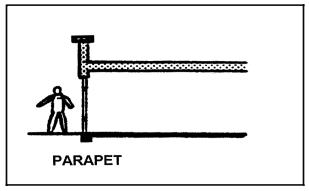
“Parcel” means a contiguous lot or tract of land owned and recorded as the property of the same persons or controlled by a single entity.
“Park” means a tract of land, designated and used by the public for active and/or passive recreation.
Parking, Shared. “Shared parking” means joint use of a parking area for more than one use.
“Parking access” means the area of a parking lot that allows motor vehicles ingress and egress from the street. “Parking area” means any public or private area, under or outside of a building or structure, designed and used for parking motor vehicles including parking lots, garages, private driveways, and legally designated areas of public streets.
“Parking lot” means an off-street, ground level open area, usually improved, for the temporary storage of motor vehicles.
“Parking space” means a clearly defined location for the parking of a motor vehicle within a public or private parking area.
“Parking structure” means a building or structure consisting of more than one level and used to store motor vehicles.
“Pawn shop” means a general retail store where used merchandise is taken for resale.
“Pavement” means:
1. A created surface, such as brick, stone, concrete, or asphalt, placed on the land to facilitate passage;
2. That part of a street having an improved surface.
“Pedestrian” means an individual who travels on foot.
“Performing arts center” means a building or group of buildings designed to permit the staging and conduct of theatre arts and performances including music, dance and/or drama.
“Perimeter” means the boundaries or borders of a lot, tract, or parcel of land or exterior buildings, walls.
“Permit” means written governmental permission issued by an authorized official, empowering the holder thereof to do some act not forbidden by law but not allowed without such authorization.
“Permitted use” means any use allowed in a zoning district and subject to the restrictions applicable to that zoning district.
“Person” means a corporation, company, association, society, firm, partnership, estate, trust, or joint stock company, as well as an individual, a state, and all political subdivisions of a state or any agency or instrumentality thereof.
“Phasing” means development undertaken in a logical time and geographical sequence.
“Place of worship” means:
1. A church, synagogue, temple, mosque, or other facility that is used for prayer by persons of similar beliefs;
2. A special purpose building that is architecturally designed and particularly adapted for the primary use of conducting on a regular basis formal religious services.
Planning Agency. Where used within this code, the term refers to the City Council serving in its dual role as the planning commission, or hearing body for planning related matters.
“Planning department” means an administrative and professional division within the municipal structure charged with the responsibility to provide long range and short term planning services and zoning administration to the community, as established by the Planning Agency.
“Plat” means:
1. A map representing a tract of land showing the boundaries and location of individual properties and streets;
2. A map of a subdivision or site plan.
“Playground” means an active recreational area with a variety of facilities, including equipment for younger children as well as court and field games.
“Plot” means:
1. A single unit parcel of land;
2. A parcel of land that can be identified and referenced to a recorded plat or map.
“Porch” means a roofed open area, which may be screened, usually attached to or part of and with direct access to or from a building.
“Prezoning” means the process or action by which cities are able to designate that portion of an unincorporated area for future annexation, with specific zoning districts which will apply upon annexation of the property to the city.
“Premises” means a lot, parcel, tract, or plot of land together with the buildings and structures thereon.
“Principal use” means the primary or predominant use of any lot or parcel.
“Prior existing use” means the use of a lot or structure at the time of the enactment of a zoning ordinance.
“Professional office” means the office of a member of a recognized profession maintained for the conduct of that profession.
“Prohibited use” means a use that is not permitted in a zone district.
“Projection” means that part of a building or structure which extends beyond the main wall of a building.
“Public areas” means parks, playgrounds, trails, paths, and other recreational areas and open spaces; scenic and historic sites; schools and other buildings and structures; and other places where the public is directly or indirectly invited to visit or permitted to congregate.
“Public building” means any building, structure, facility, or complex used by the general public, whether constructed by any state, county, or municipal government agency or instrumentality or any private individual, partnership, association, or corporation, including, but not limited to, assembly buildings, such as auditoriums, libraries, public eating places, schools, and theaters; business buildings, such as offices; and factories and industrial buildings.
“Public domain” means all lands owned by the government.
“Public hearing” means a portion of a public meeting agenda announced and advertised in advance and open to the public, with the public given an opportunity to talk and participate.
“Public improvement” means any improvement or facility, together with its associated site or right-of-way necessary to provide transportation, drainage, utilities, or other facilities that are usually owned, operated or maintained by a government agency.
“Public notice” means the advertisement of a public hearing in a paper of general circulation, and through other media sources, indicating the time, place, and nature of the public hearing and where the application and pertinent documents may be inspected.
“Public park” means a park, playground, swimming pool, beach, pier, reservoir, golf course or athletic field which is under the control, operation, or management of the city, the county, or the state.
“Public utility” means a closely regulated enterprise with a franchise for providing to the public a utility service deemed necessary for the public health, safety, and welfare. (Ord. 98-8 § 2 (part): prior code § 9-02.160)
9-04.170 “Q” definitions.
None. (Ord. 98-8 § 2 (part): prior code § 9-02.170)
9-04.180 “R” definitions.
“Ramp” means:
1. A sloping walkway, roadway, or passage used to join and provide a smooth transition between two levels of different elevations;
2. Driveways leading to parking aisles.
Recreation, Active. “Active recreation” means leisure-time activities, usually of a formal nature and often performed with others, requiring equipment and taking place at prescribed places, sites, or fields.
Recreation, Passive. “Passive recreation” means activities that involve relatively inactive or less energetic activities, such as walking, sitting, picnicking, card games, chess, checkers, and similar table games.
Recreation Facility, Private. “Private recreation facility” means a recreation facility owned, operated and used by individual family units or nonprofit organizations and intended solely for their exclusive use.
Recreational Vehicle Storage, Public/Private. “Public/private recreational vehicle storage” means a facility intended for the short or long term parking of recreational vehicles whether private or public. Public facilities are those which provide storage in designated secured spaces for fee and are only permitted within specific zoning districts. Private facilities are those provided consistent with zoning regulations upon private lots and intended only for use of the owner or occupant.
“Recycling” means the process by which waste products are reduced to raw materials and transformed into new and often different products.
“Recycling center” means a lot or parcel of land, with or without buildings, upon which used materials are separated and processed for shipment for eventual reuse in new products.
Recycling Collection, Small. “Small recycling collection” means an incidental use that serves as a neighborhood drop-off point for temporary storage of recyclables. No processing of recyclables shall take place at the recycling collection center.
“Recycling event” means a temporary event where recyclable materials are collected and separated and loaded into temporary bins to be taken to recycling centers. No on site exchange of money is given for the recyclable materials.
“Regular and substantial course of conduct” and “regular and substantial portion of business” means any adult business where one or more of the following conditions exist:
1. The area(s) devoted to the display of adult material exceeds fifteen (15) percent of the total display area of the business; or
2. The business or concern presents any type of live entertainment characterized by an emphasis on “specific sexual activity” or “specific anatomical areas parts,” or performers, models or employees appearing in public dressed only in lingerie on any four or more separate days within any thirty (30) day period; or
3. At least twenty-five (25) percent of the gross receipts of the business are derived from the sale, trade, rental, display or presentation of services, products, adult material, or entertainment which are characterized by an emphasis on matter depicting, describing, or relating to “specified sexual activities” or “specified anatomical areas.”
“Rehabilitation facilities” means a community care residential facility which provides twenty-four (24) hour, nonmedical services to adults. Rehabilitation facilities include nonmedical alcoholism or drug abuse recovery, treatment, or detoxification services to adults.
“Remodel” means to construct an addition or alter the design or layout of a building or make substantial repairs or alterations so that a change or modification to the facilities is achieved.
“Replacement cost” means the cost of replacing a building or structure with its functional equivalent.
“Research and development” means a facility for carrying on investigation in the natural, physical, or social sciences, which may include engineering and product development.
“Residential care facility for the elderly” means a community care facility, licensed by the state, providing resident health care to elderly persons who reside as a family unit or in a group setting, whether such persons are ambulatory or not.
“Restaurant” means an establishment where food and drink are prepared, served, and consumed primarily within the principal building. Food is ordered by patrons from a dining table.
Restaurant, Fast Food. “Fast food restaurant” means an establishment whose principal business is the sale of preprepared or rapidly prepared food directly to the customer in a ready-to-consume state for consumption either within the restaurant building or off the premises. Food is ordered by patrons at a counter.
“Restriction” means a limitation on property that may be created in a property deed, lease, mortgage, through certain zoning or subdivision regulations, or as a condition of approval of an application for development.
“Retail food establishment” means any facility in which food or drink is offered or prepared primarily for retail sale.
“Retail sales” means establishments engaged in selling goods or merchandise to the general public for personal or household consumption and rendering services incidental to the sale of such goods.
Retail Sales, Outdoor. “Outdoor retail sales” means the display and sale of products and services primarily outside of a building or structure, such as, vehicles, garden supplies, gas, tires and motor oil, food and beverages, boats and aircraft, farm equipment, motor homes, burial monuments, building and landscape materials, and lumber.
“Retail services” means establishments providing services or entertainment, as opposed to products, to the general public for personal or household use, including eating and drinking places, hotels and motels, finance, real estate and insurance, personal service, health, educational, and social services, museums, and galleries.
“Reverse vending machine” means an automated mechanical device which accepts one or more types of empty beverage containers and issues a cash refund or other type of redemption bonus. A reverse vending machine may sort and process containers mechanically provided that the entire process is enclosed within the machine.
“Rezone” means to change the zoning classification of particular lots or parcels of land.
“Right-of-way” means:
1. A strip of land acquired by reservation, dedication, forced dedication, prescription, or condemnation and intended to be occupied by a road, crosswalk, railroad, electric transmission lines, oil or gas pipeline, water line, sanitary storm sewer, and other similar uses;
2. Generally, the right of one to pass over the property of another.
Right-of-Way, Ultimate. “Ultimate right-of-way” means the right-of-way shown as ultimate on an adopted plan of highway alignment, or the street rights-of-way shown within the boundary of a recorded tract map or a recorded parcel map. If none of these exist, the ultimate right-of-way shall be considered the right-of-way required by the City Engineer.
“Roof” means the outside top covering of a building.
Roof, Flat. “Flat roof” means a roof that is not pitched and the surface of which is generally parallel to the ground.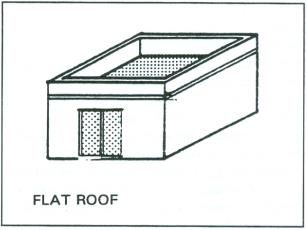
Roof, Gable. “Gable roof” means a two-planed roof assembly enclosing the triangular portion of a wall at both ends of the building.
Roof, Gambrel. “Gambrel roof” means a gabled roof with two slopes on each of two sides, the lower steeper than the upper.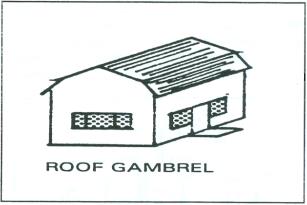
Roof, Hip. “Hip roof” means a roof with sloping ends and sides.
Roof, Mansard. “Mansard roof” means a roof with two slopes on each of four sides, the lower steeper than the upper. (Ord. 98-8 § 2 (part): prior code § 9-02.180)
9-04.190 “S” definitions.
“Satellite dish antenna” means a parabolic or dishshaped antenna or any other apparatus or device that is designed for the purpose of receiving radio waves.
“Scale” means:
1. The relationship between distances on a map and actual ground distances;
2. The proportioned relationship of the size of parts to one another.
“School” means any child care facility, or an institution of learning for minors, public or private, which offers instruction in those courses of study required by the California Education Code or which is maintained pursuant to standards set by the State Board of Education. This definition includes a nursery school, kindergarten, elementary school, junior high school, senior high school, or any special institution of education.
School, Commercial. “Commercial school” means any building or part thereof which is designed, constructed or used for education or instruction in any branch of knowledge or art form for commercial purposes.
School, Private. “Private school” means any building or group of buildings the use of which meets state requirements for elementary, secondary, or higher education and which use does not secure the major part of its funding from any governmental agency.
School, Secondary. “Secondary school” means any school licensed by the state and is authorized to award diplomas for secondary education.
“School district” means a district that serves as a unit for state financing and administration of elementary and secondary schools.
“Screening” means:
1. A method of visually shielding or obscuring one abutting or nearby structure or use from another by fencing, walls, berms, or densely planted vegetation;
2. The removal of relatively coarse floating and/or suspended solids by straining through racks or screens.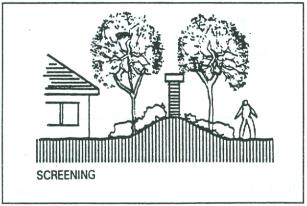
“Sea level” means a reference datum mark measuring land elevation using the level of the ocean between high and low tides.
“Senior center” means an assembly building intended to provide nonresidential services for elderly citizens.
“Service station” means any building, land area, or other premises, or portion thereof, used for: the dispensing or sales of vehicular fuels; minor servicing and repair of automobiles; and including as an accessory use the sale and installation of lubricants, tires, batteries, and similar vehicle accessories.
“Services” means establishments primarily engaged in providing assistance, as opposed to products, to: individuals, business, industry, government, and other enterprises, including hotels, and other lodging places; personal, business, repair, and amusement services; health, legal, engineering, and other professional services; educational services; membership organizations; and other miscellaneous services.
“Setback” means the distance between the building and any property line or ultimate right-of-way line of any public or private street.
“Setback line” means that line that is the required minimum distance from the centerline of a public or private right-of-way or from any lot line, and that establishes the area within which the structures must be erected or placed.
“Sexual encounter establishment” means an establishment, other than a hotel, motel or similar establishment offering public accommodations, which for any form of consideration provides a place where two or more persons may congregate, associate or consort in connection with “specified sexual activities” or the exposure of “specified anatomical areas.” This definition does not include an establishment where a medical practitioner, psychologist, psychiatrist or similar professional person licensed by the state engage in sexual therapy.
“Shopping center” means a group of industrial, office or commercial establishments planned, constructed, and managed as a total entity, with customer and employee parking provided on-site, provision for goods delivery separated from customer access, aesthetic considerations and protection from the elements, and landscaping and signage in accordance with an approved plan. A center shall consist of five or more businesses on one development site.
Shopping Mall, Enclosed. “Enclosed shopping mall” means a shopping center with limited entries from the street or parking area and where businesses have their primary frontage and major entries for the public from the interior of the structure.
“Shoulder” means the area between the moving traffic lanes and curb or edge of right-of-way used for emergency parking or open pedestrian walkway.
“Shrub” means a woody plant, smaller than a tree, consisting of several small stems from the ground or small branches near the ground; may be deciduous or evergreen.
“Sidewalk” means a paved, surfaced, or leveled area paralleling and usually separated from the street, used as a pedestrian walkway.
“Sight triangle” means a triangular-shaped portion of land established at street intersections in which nothing is erected, placed, planted, or allowed to grow in such a manner as to limit or obstruct the sight distance of motorists entering or leaving the intersection. Also known as a sight easement.
“Sign” means any object, device, display, or structure, or part thereof, situated outdoors or indoors, which is used to advertise, identify, display, direct, or attract attention to an object, person, institution, organization, business, product, service, event, or location by any means, including words, letters, figures, design, symbols, fixtures, colors, illumination, or projected images.
Sign, A-Frame. “A-frame sign” means a sign generally not securely attached or fixed to the ground or to a permanent structure used as a stationary advertising device and usually supported by two upright sign faces (also known as a “sandwich board”).
Sign, Abandoned. “Abandoned sign” means a sign whose use has ceased or has been discontinued for a period of at least ninety (90) consecutive days, or a sign identifying a business that has not occupied the premises for at least ninety (90) consecutive days.
Sign, Aggregate Area. “Aggregate area sign” means the total area of sign and/or advertising device surface.
Sign, Animated or Moving. “Animated or moving sign” means any sign or part of a sign that changes physical position or light intensity by any movement or rotation or that gives the visual impression of such movement or rotation.
“Sign,” “awning,” “canopy,” or “marquee” means a sign that is mounted, painted, or attached to an awning, canopy, or marquee that is otherwise permitted by ordinance.
Sign, Bench. “Bench sign” means a sign painted, located on, or attached to any part of the surface of a bench, seat, or chair placed on or adjacent to a public place or roadway.
Sign, Billboard. “Billboard sign” means a sign that directs attention to a business, commodity, service, or entertainment conducted, sold, or offered at a location other than the premises on which the sign is located.
Sign, Building Identification. “Building identification sign” means a sign which contains only the name of a building and/or the address of the building.
Sign, Bulletin Board. “Bulletin board sign” means a sign that identifies an institution or organization on the premises of which it is located and that contains the name of the institution or organization, the names of individuals connected with it, and general announcements of events or activities occurring at the institution or similar messages commonly referred to as an off-site sign.
Sign, Business. “Business sign” means a sign that directs attention to a business or profession conducted, or to a commodity or service sold, offered, or manufactured, or to an entertainment offered on the premises where the sign is located.
Sign, Center Identification. “Center identification sign” means any freestanding sign which identifies the name or address or directs attention to a center and which may identify the names of up to two major tenants.
Sign, Changeable Copy. “Changeable copy sign” means an advertising device which is capable of changeable text or graphics, regardless of method of attachment, which advertises events, services, or products.
Sign, Construction. “Construction sign” means a temporary sign erected on the premises on which construction is taking place, during the period of such construction, indicating the names of the architects, engineers, landscape architects, contractors or similar artisans, and the owners, financial supporters, sponsors, and similar individuals or firms having a role or interest with respect to the structure or project.
Sign, Directional. “Directional sign” means signs limited to directional messages, principally for pedestrian or vehicular traffic, such as “one-way,” “entrance,” and “exit.”
Sign, Directory. “Directory sign” means a sign listing the tenants or occupants of a building or group of buildings and that may indicate their respective professions or business activities.
Sign, Electric. “Electric sign” means any sign utilizing electricity to illuminate its surface.
Sign, Flashing. “Flashing sign” means any directly or indirectly illuminated sign that exhibits changing natural or artificial light or color effects by any means whatsoever.
Sign, Freestanding. “Freestanding sign” means any nonmovable sign not affixed to a building.
Sign, Governmental. “Governmental sign” means a sign erected and maintained pursuant to and in discharge of any governmental functions or required by law, ordinance, or other governmental regulation.
Sign, Ground. “Ground sign” means any sign, other than a pole sign, in which the entire bottom is in contact with or is close to the ground and is independent of any other structure.
Sign, Holiday Decoration. “Holiday decoration sign” means a temporary sign, in the nature of decorations, clearly incidental to and customarily and commonly associated with any national, local, or religious holiday.
Sign, Identification. “Identification sign” means a sign giving the nature, logo, trademark, or other identifying symbol, address, or any combination of the name, symbol, and address of a building, business, development, or establishment on the premises where it is located.
Sign, Illegal. “Illegal sign” means any sign, advertising display, or structure erected or constructed without first complying with all ordinances and regulations in effect at the time of its construction, erection or use, or any sign not permitted or exempted by this title.
Sign, Illuminated. “Illuminated sign” means a sign lighted by or exposed to artificial lighting either by lights on or in the sign or directed toward the sign.
Sign, Inflatable. “Inflatable sign” means any display capable of being expanded by air or other gas and used on a permanent or temporary basis to advertise a product or event.
Sign, Light-Emitting Diode. “Light-emitting diode sign” or “LED sign” means a sign consisting of one or more semiconductor diodes that emit light when a voltage is applied to it, or other similar illumination technologies.
Sign, Logo. “Logo sign” means a licensed, certified, copyrighted, or trademarked name, symbol, feature, or trademark that represents a business, enterprise, group, or activity.
Sign, Memorial. “Memorial sign” means a sign, tablet, or plaque memorializing a person, event, structure, or site.
Sign, Menu Board. “Menu board sign” means a sign displaying food items sold on the premises.
Sign, Monument. “Monument sign” means a freestanding sign designed and constructed so that the advertising structure is directly supported by a structure that is comprised of masonry products. Such signs are low profile in nature and often include landscape beds as portions of their design.
Sign, Neon. “Neon sign” means a sign consisting of multi-colored gas-filled tubing, whether or not exposed to view, energized by an electrical source.
Sign, Noncommercial. “Noncommercial sign” means any sign other than a political/election sign, or a sign relating to the sale or promotion of any merchandise, product, service, commodity, or other item or activity for private or nonprofit benefit or gain. Noncommercial signs include, but are not limited to:
1. A sign containing a message advocating, criticizing, or otherwise relating to political view, opinions, contentions on public issues, or private disputes.
2. A sign expressing religious, charitable or sociological opinions, views, policies, or beliefs.
Sign, Off-Site. “Off-site sign” means:
1. Any sign which is not located on the business or activity site it identifies or advertises;
2. Any billboard or off-premises sign.
Sign, On-Site. “On-site sign” means:
1. Any sign which directs attention to an occupancy, business, service, or activity conducted, sold, or offered upon the premises where the sign is located;
2. On-premises signs.
Sign, On-Site Informational. “On-site informational sign” means a sign commonly associated with, and not limited to, information and directions necessary or convenient for visitors coming on the property, including signs marking entrances and exits, parking area, circulation direction, restrooms, and pickup and delivery areas.
Sign, Pole. “Pole sign” means a sign that is mounted on a freestanding pole or other support so that the bottom edge of the sign face is six feet or more above grade.
Sign, Political/Election. “Political/election sign” means any sign referring or relating to a special or regular election, which sign advocates a particular vote on a measure, states views about a measure, or advocates the election of a candidate or candidates for public office at a special or regular election.
Sign, Portable. “Portable sign” means a sign that is not permanently affixed to a building, structure, or the ground.
Sign, Private Sale or Event. “Private sale or event sign” means a temporary sign advertising private sales of personal property, such as “house sales,” “garage sales,” “rummage sales,” and the like, or private not-for-profit events, such as picnics, carnivals, bazaars, game nights, art fairs, craft shows, and Christmas tree sales.
Sign, Projecting. “Projecting sign” means a sign that is wholly or partly dependent upon a building for support and that projects more than twelve (12) inches from such building.
Sign, Real Estate. “Real estate sign” means a sign pertaining to the sale or lease of the premises, or a portion of the premises, on which the sign is located.
Sign, Roof. “Roof sign” means a sign that is mounted on the roof of a building or that is wholly dependent upon a building for support and that projects above the top walk or edge of a building with a flat roof, the eave line of a building with a gambrel, gable, or hip roof, or the deck line of a building with a mansard roof.
Sign, Suspended. “Suspended sign” means a sign hanging down from a marquee, awning, or porch.
Sign, Temporary. “Temporary sign” means a sign or advertising display constructed of cloth, canvas, fabric, plywood, or other light material and designed or intended to be displayed for a short period of time. Temporary signs include banners, garage sales, open houses, or similar types of signs.
Sign, Time and Temperature. “Time and temperature sign” means an electrically operated or mechanically operated device that displays the time or temperature whether or not it displays any advertising or establishment identification.
Sign, Vehicle. “Vehicle sign” means a sign on a vehicle not customarily and regularly used to transport persons or properties.
Sign, Wall. “Wall sign” means a sign fastened to or painted on a wall of a building or structure in such a manner that the wall becomes the supporting structure for, or forms the background surface of, the sign and that does not project more than twelve (12) inches from such building or structure.
Sign, Window. “Window sign” means any sign exposed to public view, attached, painted, posted, or displayed, either permanently or temporarily, on or within one foot of the interior or exterior surface of a window.
“Sign area” means the entire face of a sign, including the advertising surface and any framing, trim, or molding but not including the supporting structure.
Sign Height. Sign height is calculated by measuring the vertical distance from the uppermost point of the sign to the ground directly beneath the sign.
Sign Program. See “Master sign program.”
“Sign projection,” on a sign attached to a wall, means the distance from the exterior wall surface to the sign element the farthest distance from such surface.
“Sign structure” means the supports, uprights, braces, cables, framework, and display surface of a sign.
“Similar use” means a use that has the same characteristics as the specifically cited uses in terms of the following: trip generation and type of traffic, parking and circulation, utility demands, environmental impacts, physical space needs, and clientele.
“Single-family housekeeping unit” means two or more occupants of a dwelling unit wherein the occupants have established ties and familiarity with each other, jointly use common areas, interact with each other, travel together, share meals, household activities, expenses and responsibilities, occupancy of the dwelling unit is stable as opposed to transient, adult occupants of the dwelling unit have control over who becomes an occupant in the dwelling unit, the adult occupants of the dwelling unit set their own rules for dwelling therein and have chosen to jointly occupy the entire premises of the dwelling unit.
“Site plan” means the development plan for one or more lots on which is shown: the existing and proposed conditions of the lot, including topography, vegetation, drainage, flood plains, wetlands, and waterways; landscaping and open spaces; walkways; means of ingress and egress; circulation; parking; utility services; structures and buildings; signs and lighting; berms, buffers, and screening devices; surrounding development; and any other information that reasonably may be required in order that an informed decision can be made by the approving authority.
“Snack bar/market” means any facility accessory to a park, athletic field, and/or clubhouse facility in which food or drink is offered or prepared primarily for retail sale.
“Social rehabilitation facility” means a community care facility through which persons receive shelter, care and training for physical or mental or sociologic conditions intended to help them return to a normal life within a community.
“Solid waste” means unwanted or discarded material, including waste material with insufficient liquid content to be free flowing.
“Solid waste disposal” means the ultimate disposition of solid waste that cannot be salvaged or recycled.
“Solid waste management” means a planned program providing for the collection, storage, and disposal of solid waste, including, where appropriate, recycling and recovery.
“Specific plan” means a plan for the long range development of properties, consistent with the local general plan, regulating the uses permitted, density allowances, distribution of uses and services, and including a program for the implementation of the plan.
“Specified anatomical areas” means and includes any of the following:
1. Less than completely and opaquely covered human genitals, pubic region, buttocks, anus or female breasts below a point immediately above the top of the areola; or
2. Human male genitals in a discernibly turgid state, even if completely and opaquely covered.
“Specified sexual activities” means and includes any of the following:
1. The fondling or other erotic touching of human genitals, pubic region, buttocks, anus or female breasts;
2. Sex acts, actual or simulated, including intercourse, oral copulation or sodomy;
3. Masturbation, actual or simulated; or
4. Excretory functions as part of or in connection with any of the activities described.
Stable, Public or Private. “Public or private stable” means a building designed for the housing or shelter of equines whether for fee or free.
“Stall” means the parking space in which vehicles park.
“Story” means that portion of a building included between the surface of any floor and the surface of the floor next above it, or if there is no floor above it, then the space between the floor and the ceiling next above it and including those basements used for the principal use.
Story, Half. “Half story” means a space under a sloping roof that has the line of intersection of the roof and wall face not more than three feet above the floor level and in which space the possible floor area with head room of five feet or less occupies at least forty (40) percent of the total floor area of the story directly beneath.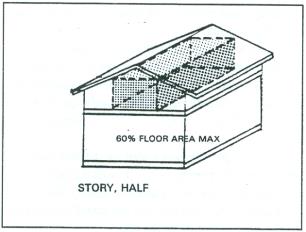
“Street” means any vehicular way that:
1. Is an existing state, county, or municipal roadway;
2. Is shown upon a plat approved pursuant to law;
3. Is approved by other official action; or
4. Is shown on a plat duly filed and recorded in the office of the county recording officer, and includes the land between the street lines, whether improved or unimproved.
Street, Arterial. “Arterial street” means a street with access control, channelized intersections, and restricted parking, that collects and distributes traffic to and from other streets in a circulation system.
Street, Collector. “Collector street” means a street that collects traffic from local streets and connects with minor and major arterials.
Street, Cul-de-sac. “Cul-de-sac street” means a street with a single common ingress and egress and with a turnaround at the end.
Street, Freeway. “Freeway street” means a limited access highway with no at grade crossings.
Street, Local. “Local street” means a street designed to provide vehicular access to abutting property and to discourage through traffic.
Street, Private. “Private street” means a street that has not been accepted by the municipality or other governmental entity.
“Street frontage” means the linear measurement of a lot along a public or private street, but not including the lineal measurement along an alley, railroad or freeway.
“Streetscape” means a design term referring to all the elements that constitute the physical makeup of a street and that, as a group, define its character, including building frontage, street paving, street furniture, landscaping, including trees and other plantings, awnings, and marquees, signs, and lighting.
“Streetscape furniture” means constructed, above-ground objects, such as outdoor seating, kiosks, bus shelters, sculpture, tree grids, trash receptacles, fountains, and telephone booths that have the potential for enlivening and giving variety to streets, sidewalks, plazas, and other outdoor spaces open to, and used by, the public.
“Structural alteration” means any change in either the supporting members of a building, such as bearing walls, columns, beams, and girders, or in the dimensions or configurations of the roof or exterior walls.
“Structure” means a combination of materials to form a construction for use, occupancy, or ornamentation whether installed on, above, or below the surface of land or water or affixed to a building.
“Subdivision” means the division of a lot, tract, or parcel of land into two or more lots, tracts, or parcels, of land for sale, lease or finance.
“Substantial improvement” means any extension, repair, reconstruction, or other improvement of a property, the cost of which equals or exceeds fifty (50) percent of the fair market value or assessed value of a property either before the improvement is started or, if the property has been damaged and is being restored, before the damage occurred.
“Supermarket” means an establishment primarily selling food as well as other convenience and household goods.
“Supportive housing” shall have the same definition as provided in Health and Safety Code Section 50675.14 and as it may be amended, wherein it means housing with no limit on length of stay that is occupied by the target population, and that is linked to on-site or off-site services that assist the supportive housing resident in retaining the housing, improving his or her health status, and maximizing his or her ability to live, and when possible, work in the community.
“Swim club” means a public or private organization encouraging and supporting aquatic sports or performances. (Ord. 2016-6 § 3 (part), § 4; Ord. 2012-5 § 2; Ord. 2011-2 § 1 (Exh. A (part)); Ord. 2009-3 § 1 (Exh. A (part)); Ord. 98-8 § 2 (part): prior code § 9-02.190)
9-04.200 “T” definitions.
“Taking” means to expropriate, acquire, or seize property or species without compensation or license so to do.
“Target population” means persons, including persons with disabilities, and families who are “homeless,” as that term is defined by Section 11302 of Title 42 of the United States Code, or as may be amended, or who are “homeless youth,” as that term is defined by paragraph (2) of subdivision (e) of Section 11139.3 of the Government Code, or as may be amended.
“Tavern” means an establishment used primarily for the serving of liquor by the drink to the general public and where food or packaged liquors may be served or sold only as accessory to the primary use.
“Temporary outdoor activity” means activities that are carried out primarily out-of-doors for a fixed period of time and including flea markets, fireworks, displays, speeches, farm stands, seasonal sales, swap and shop markets, racing meets, circuses, carnivals, concerts, and parades.
“Temporary structure” means a structure without any foundation or footings and that is removed when the designated time period, activity, or use for which the temporary structure was erected has ceased.
“Temporary use” means a use established for a limited duration with the intent to discontinue such use upon the expiration of the time period.
“Tenant” means an occupant of land or premises who occupies, uses, and enjoys a real property for a fixed time, usually through a lease arrangement with the property owner and with the owner’s consent.
“Tennis club” means a public or private organization encouraging and supporting the participation in the game of tennis for fun or profit.
“Terminal” means:
1. A place where transfer between modes of transportation takes place;
2. A terminating point where goods are transferred from a truck to a storage area or to other trucks or another form of transportation.
“Terrace” means a level, landscaped, and/or surfaced area, also referred to as a patio, directly adjacent to a principal building at or within three feet of the finished grade and not covered by a permanent roof.
“Theater” means a building or part of a building devoted to showing motion pictures or for dramatic, dance, musical, or other live performances.
“Tot lot” means an improved and equipped play area for small children usually up to elementary school age.
“Towing facilities – indoor vehicle impound and indoor towing service business – (indoor only)” means an indoor facility used exclusively for the indoor storage or holding of automobiles, motor vehicles, and recreational vehicles impounded or towed pursuant to order of a public law enforcement agency, insurance company, private party tow, roadside assistance, or similar use, and stored pending the return of the vehicle to its owner. This definition does not include wrecking, salvaging, scrapping, sale of vehicles or vehicle parts, or the dismantling of vehicles except pursuant to law enforcement investigation.
“Toxic substances” means any combination of contaminants, including disease-carrying agents, that, after discharge and upon exposure, ingestion, inhalation, or assimilation into any organism, can cause death or disease, mutations, deformities, or malfunctions in such organisms, or their offspring, and that adversely affect the environment.
“Traffic zone” means a geographically defined area within which various traffic related statistics and plans are prepared.
“Trailer” means a structure standing on wheels, towed or hauled by another vehicle, and used for short-term human occupancy; carrying of materials, goods, or objects; or as a temporary office.
“Transfer station” means an intermediate destination for solid waste.
“Transitional housing” and/or “transitional housing development” shall have the same definitions as provided in Health and Safety Code Section 50675.2 and as it may be amended, wherein it means buildings configured as rental housing developments, but operated under program requirements that call for the termination of assistance and recirculation of the assisted unit to another eligible program recipient at some predetermined future point in time, which shall be no less than six months.
“Transportation corridor” means:
1. A combination of principal transportation routes involving a linear network of one or more lanes, rail lines, or other primary and secondary access facilities that support a development corridor; and
2. A designated transportation/circulation alignment connecting various geographic points.
“Transportation demand management plan” means a system of actions and timetables to alleviate traffic problems through improved management of vehicle trip demand. Strategies aimed at reducing the number of vehicle trips, shortening trip lengths, and changing the timing of trips out of peak hours.
“Trip” means a single or one-way motor vehicle movement either to or from a subject property or study area.
“Trip ends” means the total of trips entering and leaving a specific land use or site over a designated period of time.
“Trip generation” means the total number of trip ends produced by a specific land use or activity.
“Trip generation rate” means a statistical projection of occurrence based upon a twenty-four (24) hour period of vehicular trips created by land uses.
“Truck terminal” means an area and building where trucks load and unload cargo and freight and where the cargo and freight may be broken down or aggregated into smaller or larger loads for transfer to other vehicles or modes of transportation and where routine maintenance may be performed. (Ord. 2017-4 § 4; Ord. 2016-6 § 3 (part); Ord. 2012-5 §§ 3, 4; Ord. 98-8 § 2 (part): prior code § 9-02.200)
9-04.210 “U” definitions.
“Underground utilities” means the placement of electric, telephone, cable, and other utilities in underground vaults or trenches.
“Use” means the purpose or activity for which land or buildings are designed, arranged, or intended or for which land or buildings are occupied or maintained.
Utility, Private or Public. “Private or public utility” means:
1. An agency that, under public franchise or ownership, or under certificate of convenience and necessity, or by grant of authority by a governmental agency, provides the public with electricity, gas, heat, steam, communications, transportation, water, sewage collection, or other similar service;
2. A closely regulated enterprise with a franchise for providing a needed service.
“Utility easement” means the right-of-way acquired by a utility or governmental agency to locate utilities, including all types of pipelines, telephone and electric cables, and towers.
“Utility services” means the generation, transmission, and/or distribution of electricity, gas, steam, communications, and water; the collection and treatment of sewage and solid waste; and the provision of mass transportation. (Ord. 98-8 § 2 (part): prior code § 9-02.210)
9-04.220 “V” definitions.
“Variance” means permission to depart from the literal requirements of a zoning ordinance.
Vehicle, Motor. “Motor vehicle” means a self-propelled device used for transportation of people or goods over land surfaces and licensed as a motor vehicle.
“Vehicle body repair, paint or restoration” means a commercial use often referred to as body and fender shops through which damaged or wrecked vehicles are restored to operable and aesthetic conditions.
“Vehicle leasing and rental” means a business whose principal purpose is to provide vehicles to serve customer transportation needs. Such vehicles may include automobiles, trucks, bicycles, motorcycles, trailers and/or recreational vehicles.
“Vehicle repair” means a commercial business specializing in the repair and service of automobiles, trucks or similar conveyances but not including body and fender work. Such work may include engine tuning, lubrication, tire services and sales, component installations.
“Vehicle sales area” means an open area, other than a right-of-way or public parking area, used for display, sale, or rental of new or used vehicles in operable condition and where no repair work is done.
“Veterinary clinic” means a place where animals are given medical care and the boarding of animals is limited to short-term care incidental to the hospital use. (Ord. 98-8 § 2 (part): prior code § 9-02.220)
9-04.230 “W” definitions.
“Wall” means:
1. The vertical exterior surface of a building;
2. Vertical interior surfaces that divide a building’s space into rooms.
“Warehouse” means a building used primarily for the storage of goods and materials.
“Waste management facility” means a building, group of buildings, or parcel of land upon which or within which solid waste management occurs. Such uses include materials recycling facilities, collection facilities and transfer facilities.
“Waste transfer facility” means a facility in which solid waste materials are received in typical customer service garbage trucks and is transferred to a larger transport vehicle for transfer to a land fill. Some recycling may occur accessory to preparing the waste for shipping to the landfill.
“Wheel stops” means permanent devices in each parking stall that block the front wheels of a vehicle. (Ord. 98-8 § 2 (part): prior code § 9-02.230)
9-04.240 “X” definitions.
None. (Ord. 98-8 § 2 (part): prior code § 9-02.240)
9-04.250 “Y” definitions.
“Yard” means an open space that lies between the principal building or buildings and the nearest lot line. The minimum required yard as set forth in the ordinance is unoccupied and unobstructed from the ground upward except as may be specifically provided for in the zoning ordinance.
Yard, Front. “Front yard” means a space extending the full width of the lot between any building and the front lot line and measured perpendicular to the building at the closest point to the front lot line.
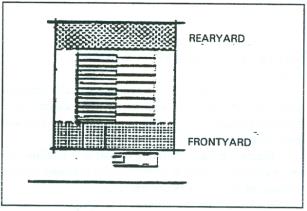
Yard, Rear. “Rear yard” means a space extending across the full width of the lot between the principal building and the rear lot line and measured perpendicular to the building to the closest point of the rear lot line.
Yard, Required. “Required yard” means the open space between a lot line and the yard line within which no structure shall be located except as provided for in the zoning ordinance.
Yard, Side. “Side yard” means a space extending from the front yard to the rear yard between the principal building and the side lot line and measured perpendicular from the side lot line to the closest point of the principal building. (Ord. 98-8 § 2 (part): prior code § 9-02.250)
9-04.260 “Z” definitions.
“Zone” means a specifically delineated area or district within which uniform regulations and requirements govern the use, placement, spacing, and size of land and buildings.
“Zoning” means the delineation of districts and the establishment of regulations governing the use, placement, spacing, and size of land and buildings.
“Zoning map” means the map or maps that are a part of the zoning ordinance and delineate the boundaries of zone districts. (Ord. 98-8 § 2 (part): prior code § 9-02.260)


